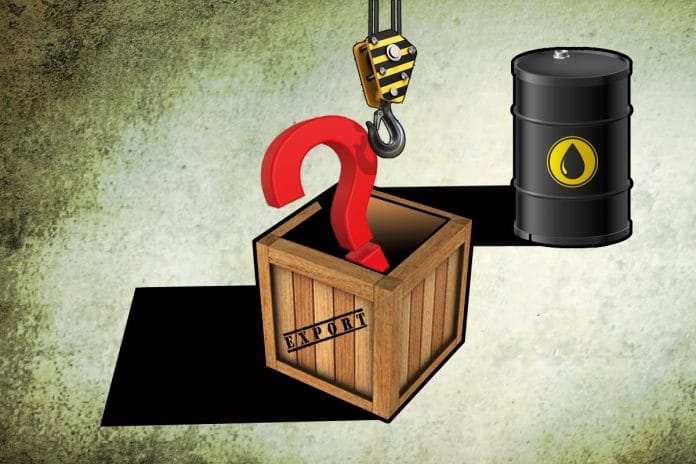Attention has to be focused on the relative stagnation in merchandise exports over the medium term.
The 13 per cent fall in the dollar value of the rupee so far this calendar year has focused attention on the country’s growing deficit on trade in goods and services. This deficit has increased dramatically with the rise in crude oil prices. Even after including the inflow of remittances, it is expected to be about 2.6 per cent of gross domestic product in 2017-18, the highest that it has been since 2012-13. In its response, the government has talked of promoting exports and curbing “non-essential” imports.
 There is good reason to worry about the stagnation in exports, by which is usually meant merchandise exports. If one takes out the oil factor because its sharp price fluctuations distort the overall picture, the disappointing fact is that non-oil exports have grown very slowly this decade, from $210 billion in 2010-11 to $265 billion in 2017-18. This represents barely 26 per cent growth over seven years, and an annual average growth rate of 3 per cent, and stands in sharp contrast to export performance until 2010-11. Non-oil exports in the 1990s grew by 140 per cent, and in the decade of the noughties, by an even more impressive 395 per cent. On present reckoning, the current decade may see non-oil export growth of somewhere between 40 per cent and 50 per cent — representing a sharp deceleration.
There is good reason to worry about the stagnation in exports, by which is usually meant merchandise exports. If one takes out the oil factor because its sharp price fluctuations distort the overall picture, the disappointing fact is that non-oil exports have grown very slowly this decade, from $210 billion in 2010-11 to $265 billion in 2017-18. This represents barely 26 per cent growth over seven years, and an annual average growth rate of 3 per cent, and stands in sharp contrast to export performance until 2010-11. Non-oil exports in the 1990s grew by 140 per cent, and in the decade of the noughties, by an even more impressive 395 per cent. On present reckoning, the current decade may see non-oil export growth of somewhere between 40 per cent and 50 per cent — representing a sharp deceleration.
Also read: India was asked to choose between society and economy in 2014. Now they have neither
In the same period, non-oil imports too slowed, the figure going from $288 billion for 2010-11 to $350 billion in 2017-18. This represents growth of barely 21 per cent — or less than the growth of exports in the same period. Therefore, one might ask, why worry? Even in absolute terms, the non-oil deficit in merchandise trade has grown only modestly from $55 billion to $62 billion over seven years. The issue, as always, is oil.
For a while, it seemed that software exports would turn out to be India’s substitute for oil, with software exports growing to about the size of the oil import bill. This has indeed happened, since software exports grew from a very modest $6.3 billion in 2000-01 to $47.6 billion in 2010-11, and further to over $160 billion last year — or much more than the year’s oil import bill of $109 billion.
Oddly enough, though, the Reserve Bank’s monthly releases on services trade have some contradictory numbers, and do not show quite so positive a picture. For instance, the official data show that overall services exports were $137 billion in 2011-12, or much more than twice the level of software exports. However, the Reserve Bank figure for services exports in 2017-18, at $163 billion, is not only smaller than the software export figure put out by the industry, it also shows slow growth in overall services exports, of 19 per cent over six years from 2011-12. These numbers need to be reconciled with what the industry has been putting out.
What is worth noting is that the net surplus on services trade has moved relatively modestly. Thus, in 2011-12, overall services imports totalled $86 billion, yielding a net surplus of $51 billion. Last year’s services imports totalled $102 billion, yielding a net sum of $61 billion, representing growth of no more than $10 billion, or a fraction short of 20 per cent, over six years. This increase is very much less than the impression one might get by looking only at the industry numbers for software exports.
Also read: GDP numbers have become phallic symbols for Congress & BJP
The relative stagnation in the net surplus on services trade means that it has started falling short of the net deficit on trade in oil, which was $85 billion last year, compared to net services surplus of $61 billion. In 2010-11, the two numbers were much closer together. This year, the gap is likely to be even bigger.
In short, services exports have not proved to be the answer to India’s oil import problem, and attention has to be focused on the relative stagnation in merchandise exports over the medium term. This is especially noticeable in once dynamic sectors like garments and pharmaceuticals.
By Special Arrangement with Business Standard.







The trade fued between The United States of America and China should be exploited by BHARAT.
As the supply chains in Chinese Manufacturing Snap, BHARAT will pick them up.
First such example being SAMSUNG Mobile plant in BHARAT, the world’s largest and will EXPORT 30% of what is assembled there across the world !!
Software exports and remittances have kept us afloat. India exports barely as much as Thailand. Some of our exports such cut and polished diamonds, petroleum products have a high import content. The key lies in manufactured goods exports, for which the manufacturing sector needs to be more globally competitive. 2. Curbing “ non essential “ imports takes us back to our socialist past. Indians now spend so much on foreign travel, sending their children abroad to study, some with a dozen personal attendants. Logically, that would be a place to cut.